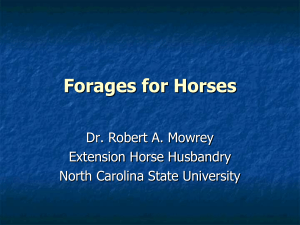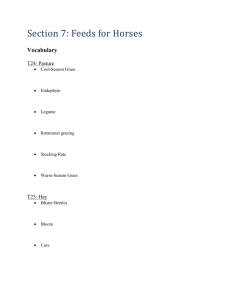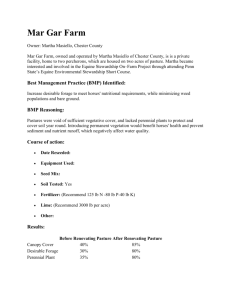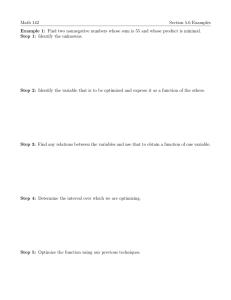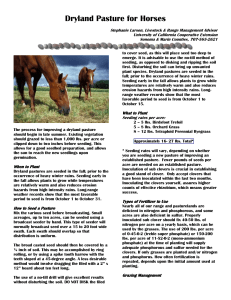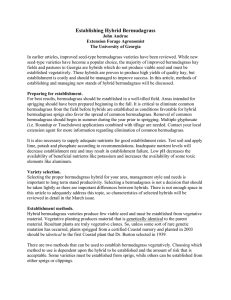cooperativ n service Bermudagrass for Forage in Central Arizona Q117
advertisement
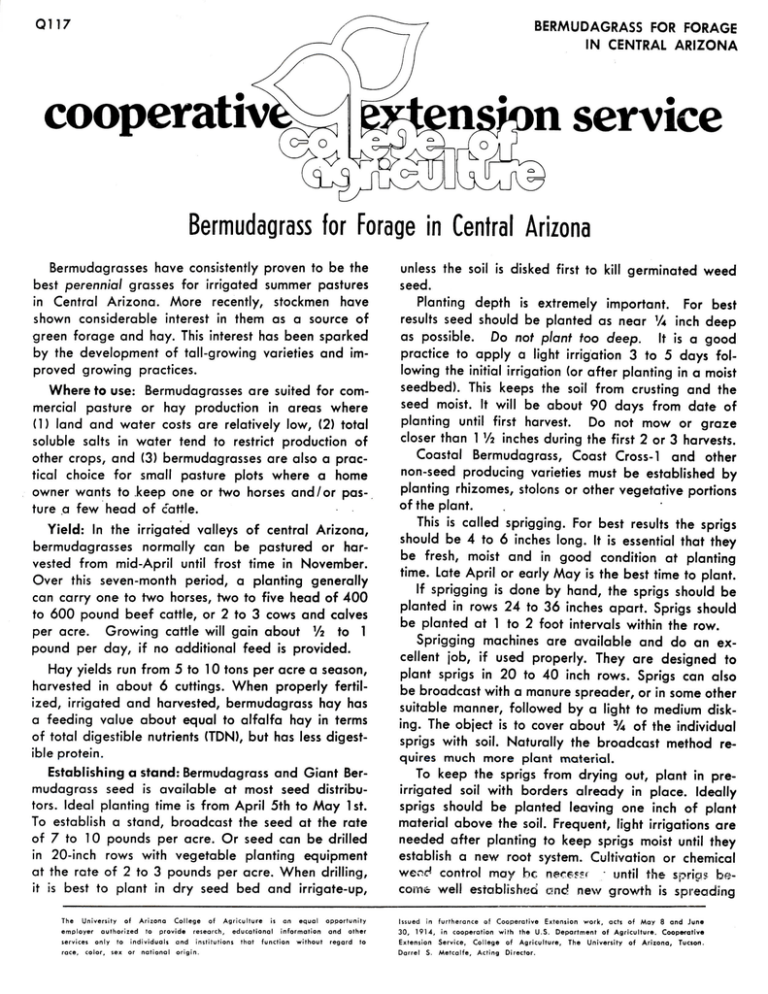
Q117 BERMUDAGRASS FOR FORAGE IN CENTRAL ARIZONA cooperativ n service Bermudagrass for Forage in Central Arizona Bermudagrasses have consistently proven to be the best perennial grasses for irrigated summer pastures in Central Arizona. More recently, stockmen have shown considerable interest in them as a source of green forage and hay. This interest has been sparked by the development of tall-growing varieties and improved growing practices. Whereto use: Bermudagrasses are suited for commercial pasture or hay production in areas where (1) land and water costs are relatively low, (2) total soluble salts in water tend to restrict production of other crops, and (3) berrnudagrasses are also a practical choice for small pasture plots where a home owner wants to .keep one or two horses and/or pasture a few head of cattle. Yield: In the irrigated valleys of central Arizona, berrnudagrasses normally can be pastured or harvested from mid-April until frost time in November. Over this seven-month period, a planting generally can carry one to two horses, two to five head of 400 to 600 pound beef cattle, or 2 to 3 cows and calves per acre. Growing cattle will gain about Vz to 1 pound per day, if no additional feed is provided. Hay yields run from 5 to 10 tons per acre a season, harvested in about 6 cuttings. When properly fertilized, irrigated and harvested, bermudagrass hay has a feeding value about equal to alfalfa hay in terms of total digestible nutrients (TON), but has less digestible protein. Establishing a stand: Bermudagrass and Giant Bermudagrass seed is available at most seed distributors. Ideal planting time is from April 5th to May 1st. To establish a stand, broadcast the seed at the rate of 7 to 10 pounds per acre. Or seed can be drilled in 20-inch rows with vegetable planting equipment at the rate of 2 to 3 pounds per acre. When drilling, it is best to plant in dry seed bed and irrigate-up, The University of Arizona College of Agriculture is an equal opportunity employer authorized to provide research, educational information and other services only to individuals and institutions that function without regard to race, color, sex or national origin. unless the soil is disked first to kill germinated weed seed. Planting depth is extremely important. For best results seed should be planted as near V* inch deep as possible. Do not plant too deep. It is a good practice to apply a light irrigation 3 to 5 days following the initial irrigation (or after planting in a moist seedbed). This keeps the soil from crusting and the seed moist. It will be about 90 days from date of planting until first harvest. Do not mow or graze closer than 1 '/z inches during the first 2 or 3 harvests. Coastal Bermudagrass, Coast Cross-! and other non-seed producing varieties must be established by planting rhizomes, stolons or other vegetative portions of the plant. This is called sprigging. For best results the sprigs should be 4 to 6 inches long. It is essential that they be fresh, moist and in good condition at planting time. Late April or early May is the best time to plant. If sprigging is done by hand, the sprigs should be planted in rows 24 to 36 inches apart. Sprigs should be planted at 1 to 2 foot intervals within the row. Sprigging machines are available and do an excellent job, if used properly. They are designed to plant sprigs in 20 to 40 inch rows. Sprigs can also be broadcast with a manure spreader, or in some other suitable manner, followed by a light to medium disking. The object is to cover about % of the individual sprigs with soil. Naturally the broadcast method requires much more plant material. To keep the sprigs from drying out, plant in preirrigated soil with borders already in place. Ideally sprigs should be planted leaving one inch of plant material above the soil. Frequent, light irrigations are needed after planting to keep sprigs moist until they establish a new root system. Cultivation or chemical we.-MH control may be nece«s< until the sprigs become well established anc! new growth is spreading Issued in furtherance of Cooperative Extension work, acts of May 8 and June 30, 1914, in cooperation with the U.S. Department of Agriculture. Cooperative Extension Service, College of Agriculture, The University of Arizona, Tucson. Darrel S. Metcalfe, Acting Director. rapidly. It usually takes about 90 days for a new planting to produce sufficient growth for the first harvest. Fertilization: Bermudagrasses are heavy and efficient users of nitrogen. Up to 400 pounds of actual nitrogen per acre per year can be used to advantage on soils receiving no manure or "free" nitrate in the irrigation water. Good control of irrigation is essential to avoid wasting nitrogen in tailwater run-off. A total of 200 to 300 pounds of actual nitrogen per acre annually is the normal recommendation. This should be applied in 3 to 4 uniform applications of 75 to 80 pounds per acre. The first application should be made in early March as the grass begins to turn green, and the last application in late August or early September. Irrigation: The water requirements of bermudagrasses will vary slightly from one year to the next and from one area to another, but a total of 5 to 6 acre-feet of water per acre per year is needed. Frequency of irrigations and amount of water needed each time depends on the soil and time of year. During the growing season on most soils, Bermudagrass needs two irrigations of 4 to 6 acre-inches each between harvests. More frequent and lighter irrigations may be needed on sandy or shallow soils and heavier, less frequent irrigations on heavy soils. One or .two heavy irrigations should be applied during the winter to help maintain the stand and to put a good supply of moisture deep into the ground for use during the growing period. Pasture management: To get cattle to eat the maximum amount of available forage with a minimum of waste some form of strip grazing is recommended. This is best accomplished by confining the stock to a section of the pasture that will be grazed off in 2 or 3 days. One of the most practical methods is to use a portable electric fence. It can be moved to expose fresh pasture every second or third day. With vigorous pasture growth a stocking rate of up to 15 animals per acre may be carried. A second method is to divide the pasture into smaller plots with permanent fences. When a section or plot has been grazed off and before irrigating, droppings can be broken up and spread out by using a flexible harrow. Weeds and rank growth that tends to accumulate around droppings can be clipped with a mower. These clippings can be windrowed on top of irrigation borders where they will be eaten by the stock during the next pasturing. Dry fertilizer applications can also be made at this time. These good pasture management practices may not be necessary after each grazing, but should be carried out when needed. Following irrigation during the regrowth period, the top soil will have time to dry before stock is put back on the plot. This will prevent soil compaction increasing the length of stand and productivity of the pasture. When grazing bermudagrasses, try to keep them under 6 inches in height. During periods when the stock cannot keep the pasture grazed to this extent, it is advisable to cut the excess growth for greenchop or hay. If the clipped forage is not excessive, it can be windrowed on the borders and left for the stock to eat as mentioned previously. Irrigated pastures can become infested with internal parasites. Stock should be watched closely for signs of infestation. Hay making: Bermudagrasses should be cut for hay when they are 1 2 to 15 inches high. If allowed to grow taller, it lodges (falls over) making harvest difficult. When mowing, use a sickle with smooth, sharp blades. Blades with smooth cutting edges do a better job of cutting bermudagrasses than do ones with serrated edges. Leave bermudagrass hay in the swath only long enough to dry sufficiently for safe baling and stacking. Overcuring will not result in leaf loss, but will bleach out and result in lower feeding value. Winter pasture: Bermudagrasses may be overseeded with annual ryegrass, barley or oats to provide winter pasture. If you have any questions, contact your county office, Cooperative Extension Service. (Look in the telephone directory under COUNTY listings.) The agricultural agent there can answer any further questions on this and many other subjects. About the authors . . . Otis G. Lough and Herold Loughead are Extension agricultural agent and livestock specialist, respectively. Both are faculty of the College of Agriculture, The University of Arizona, Tucson. March 1979
